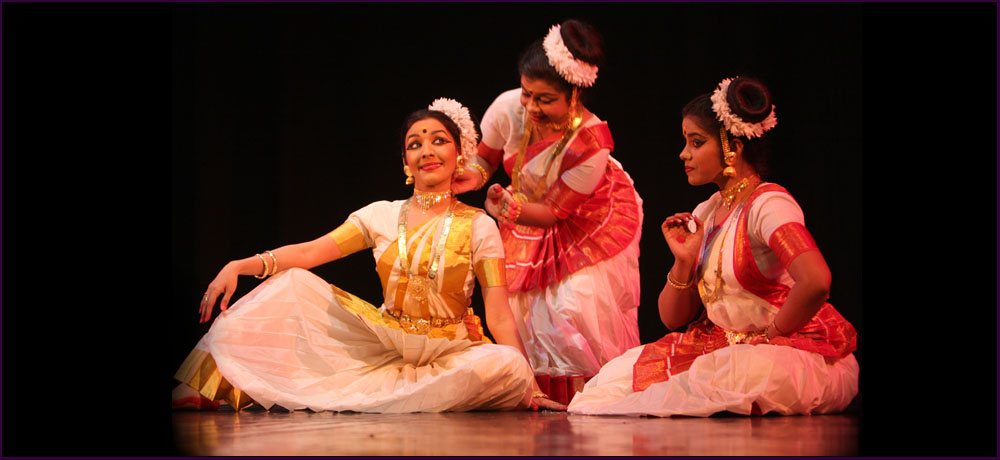

Monday, 8th
October 2012

Mohiniattam -
Vijaylakshmi and group (Delhi)
| |
Reminiscent
of ocean waves, swaying palms and lush paddy fields is, literally,
the dance of the mythical enchantress Mohini. This traditional style
was once performed by devadasis in temples which grew over time
and acquired a classical status. Performed only by women, the form
reveals the lasya aspect of dance. Hence, the prevailing rasa, or
aesthetic mood, is of shringara (erotic) – also a metaphor
for man’s desire for the divine. Some scholars trace the style
to the 2nd or 3rd century AD – the era of the great Tamil
epic Silappadikaram. Others believe it was created in the mid-18th
century in the court of Maharaja Swati Tirunal of Travancore. But
like all Indian dance, Mohiniyattam has evolved over several hundred
years surviving a difficult phase in the last century. Music in
Mohiniyattam has a special quality. The punctuated thrust of rhythmic
nuances in vocal rendition is preserved in the mnemonic language
of drums such as Edakka, Madhalam, Timila and Chenda. Chengila,
a kind of gong, helps the singer to keep time. Vijayalakshmi is acknowledged as one of the most eminent exponents of Mohiniyattam today. A unique combination of a researcher and performer, Vijayalakshmi has endeavoured to constantly expand traditional boundaries through innovative choreography inspired by a pan-Indian and global perspective. She has played a significant role in rejuvenating this beautiful Indian classical dance form with innovative productions, including Unniarcha (inspired by Kalaripayattu, the ancient martial art form); Swan Lake, inspired by the music of the celebrated Russian composer Tchaikovsky; and Paryapti, which draws upon the rich cultural ethos and music of Bengal. Variously honoured, Vijayalakshmi has performed at some of some very prestigious venues in India and the world, including the Lincoln Center, the Bolshoi Theatre, the Edinburgh International Festival and the World Music Institute, New York. |
| |
Presentation Paryapti provides the perfect mirror
to reflect the quintessential femininity of Mohiniyattam in its
celebration of Durga, the patron deity of Bengal and embodiment
of the Feminine. It is this thread that binds the cultures of Kerala
and Bengal that the artistes emphasise in Paryapti. The presentation
celebrates the inherent divinity in all things by exploring the
culture and status of courtesans in India. Courtesans have been
extolled by poets in Indian literature as being highly accomplished
and epitomised in Indian mythology by Parvati, Shiva’s consort.
Over the ages, these women played a significant role in the evolution
and preservation of Indian music and dance. At the turn of the 20th
century, however, they were condemned due to the misplaced morality
and orthodoxy that took root in India. According to a Bengali folk
legend, these women pleaded with Shiva for compassion. The Lord
blessed them saying when Parvati’s homecoming was celebrated
on earth as Durga, her clay image would be complete only if the
idol included the soil from their house. To this day, the soil from
a sex worker’s house is a traditional requisite for the consecration
of Durga’s idol. The ceremony redefines the sacred, underlines
its inclusiveness, and is symbolic of an outcast woman’s desire
for fulfillment, or Paryapti. |













